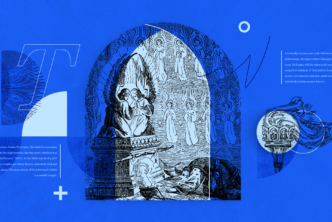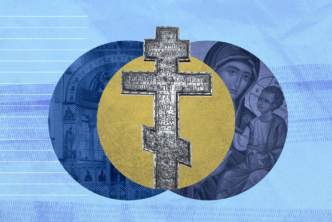The risen Lord, Jesus of Nazareth, the Word-made-flesh, established for himself a great company of saints which is, as it were, the Word-confessed. The church is the company of saints who confess Christ while being sustained by the Word’s “continual outgoing presentation.”1 Christ presents himself in her praises, for she is one with Christ as his bride (Eph 5:25–33). The Father’s delight in the Son extends like a canopy over her—for Christ’s self-presentation to the world is only complete in and with her as the totus Christus.2 Her life shares in the Son’s praises of the Father in the Spirit.3
In this economy of “confession,” wherein the church bears continual witness to the One who summoned her into being, we can locate the role of councils and creeds. I will argue for two propositions. First, councils and creeds are the historical embodiment of the church’s impulse to unify the content of her confession of the Word. That is, councils and creeds are historical instances of the church learning to coherently confess her Lord in one voice. Second, the same impulse which is manifest in the gathering of ecumenical councils ought to animate rigorous ecumenical dialogue today (whether that issues in an ecumenical council or not).
Table of contents
Councils, creeds, and confession
The Arian conflict famously began when Bishop Alexander of Alexandria taught on the unity of the Trinity. One of his priests—Arius—disputed the issue, arguing, “If the Father begat the Son, he that was begotten has a beginning of existence. From this, it is evident, that there was a time when the Son was not.”4 The conflict eventually set ablaze the Christian world with theological controversy. A young deacon of Alexandria named Athanasius took the lead in defending what would become orthodoxy: the Son had no beginning but was “consubstantial” with the Father. Constantine, out of a desire for the unity of the church, subsequently called the famous Council of Nicaea.5
Contrary to popular belief, Constantine did not determine the decision of the council. Rather, over three hundred bishops representing various parts of the Christian world gathered to judge Arius’s beliefs, engaging in rigorous debate.6 After this debate, all but five or six bishops assented to the Nicene declaration of faith—the Nicene Creed (AD 325).7 The most contentious part of the creed would prove to be the word homoousion, by which the Nicene fathers declared that the Father and Son were “consubstantial” or “of the same substance.”
In the immediate wake of Nicaea, some worried that the term homoousios supported Sabellianism—the notion that the Father, Son, and Spirit are three different “modes” or ways the one God appears in time (as though he wears the Father-mode at one time, the Son-mode at a different time, and the Spirit-mode at yet another time).8 What emerged was a broad family of views. At the Synod of Antioch after Nicaea, the creed was altered to remove the term “consubstantial.”9 Still two others at the Synod of Sirmium affirmed that the Son was begotten by the Father’s will or that the Father was greater in deity than the Son, even though the Son was thought to be eternal.10 Athanasius labeled anything less than an affirmation of the consubstantiality of the Son with the Father as “Arianism.”11 What united the various families of “Arianism” was the affirmation that the Son is inferior to the Father.
Increasing conflict threatened to tear the church. For instance, yet another group took aim at the deity of the Holy Spirit. The pneumatochoi, or the “Spirit-fighters,” argued that the Holy Spirit was not a distinct person.12 The prevalence of the Arian views and the denials of the Spirit’s deity eventually led to the second ecumenical council, or the First Council of Constantinople. Here, the Nicene creed was reaffirmed and an affirmation of the Spirit’s deity was added, yielding the creed we recite today.13
What did the creeds seek to express?
This brief survey of history helps us locate the function of the ecumenical councils, and the creeds issuing therefrom, in the life of the church. They emerged in a context of controversy and mass dissent. The voice of the creed is the voice of a church seeking to unify her own voice amidst a cacophony. However, the unity the creeds sought to wrought was not one built on “meeting in the middle,” as it were. Athanasius and others like him refused to give up the word homoousios, even when it seemed like they were being recalcitrant hardliners. Hence, the consubstantiality of the Father and Son found itself reaffirmed in the Nicene–Constantinopolitan Creed. Rather, the creeds sought to express a common confession of the truth of Christ. And there is a good theological reason why this must be so: The church is not the community of those united for the sake of unity itself, but those united by a confession consisting of the praise, adoration, and worship of the living God who rescues sinners in Jesus Christ.
The church is not the community of those united for the sake of unity itself, but those united by a confession consisting of the praise, adoration, and worship of the living God who rescues sinners in Jesus Christ.
What is the confessing church?
To see this point, let us try to understand what happened from Nicaea to Constantinople through a theological telling that starts with an ontology of the church. What is the church? As I’ve argued above, the church is, in a manner, the Word-confessed. That is, she has her existence in the Word’s self-presentation through her. She exists via participation in the Word’s confession of love for the Father in the Spirit. “Confession,” here, does not merely denote sheer definition. Confession is the act of astonished adoration which obediently gives allegiance to the risen Christ as the true Lord over and against all other claimants to human allegiance.14 In this very act of confession, the church exists not merely as a creature of the Word (contra Webster—though she is this), but as the One united with the Word. By the Spirit, the Lord Jesus shares his own cry of sonship (Gal 4:4), such that the church can be said to somehow be Christ.15 The church is “the fullness of Christ” per Ephesians 1:22–3316 —not that we add anything to Christ, but that Christ counts his self-manifestation to the world as complete by the existence of the church. The church is therefore the company of those in whom and through whom Christ sings the praises of the Father by the Spirit in lips not his own. The poet Gerard Manley Hopkins expressed it: “Christ plays in ten thousand places, lovely in limbs, and lovely in eyes not his, to the Father through the features of men’s faces”17 —and loveliest still in the church. She is fully herself when her words in the world are set aglow with the Word, mediating the Word’s own speech in her own words. During the confusion of the Arian crisis, then, the church sought to understand the very song of praise she sang in the world. She sought to understand the One from whom she sang, and his relation to the One to whom are all things (Rom 11:36; 1 Cor 8:6). And because the Life from whom she derives her own life is precious, she sought to get her testimony to that Life right.
The ecumenical councils, understood in this light, are the events in which the church said, “This is the song we sing—and no other. And this is the One of whom we sing—and no other.” They are events of the church’s self-awareness of her confession coming to fuller light and robust catholic expression. The church had to be dogmatic (even about a word like homoousious) precisely because her confession—and thus the foundation of her existence—was at stake. Because the church seeks to confess the Father in the Son by the Spirit, the unity of its confession could not be a unity built on compromise but on clarity. Otherwise, the face of the One for whom she is called into being—to “proclaim the excellencies” of the One who called her (1 Pet 2:9–10)—would be obscured rather than proclaimed in her voice. If the church is impelled by the Spirit towards this coherent confession in which she sings in harmony (not cacophony) the praises of God in Christ, then the ecumenical councils, if they are authentic expressions of the church’s voice, can only be the rigorous attempt to find the structure of the song and do away with cacophony. And in fact, this is precisely what happened at Nicaea and Constantinople; this is why the pluralism of opinion about the “consubstantiality” of the Father and Son was ultimately rejected.
Ecumenical councils and ecumenical conversation
The impulse towards the commonality of confession is precisely the same impulse on which successful ecumenism is built. There are two dimensions of the individual’s own participation in the church’s impulse towards coherent confession that I want to highlight for ecumenical efforts.
First dimension
First, insofar as the corporate church aches to sing a unified song, those in the church will therefore long to sing harmoniously with each other. This follows from the fact that the church’s nature as the confessing-one is the historical shape of its nature as the great society of trinitarian love (these “natures” are in fact only one). The church is the company of those tending towards a determinate destiny beautifully described by Jonathan Edwards:
No moral or natural defect shall ever enter there; and there nothing be seen that is sinful, or weak, or foolish; nothing, the nature or aspect of which is coarse or displeasing, or that can offend the most refined taste, or the most delicate eye. No string shall there vibrate out of tune, to cause any jar in the harmony of the music of heaven; and no note be such as to make discord in the anthems of saints and angels.18
Insofar as the church is the in-breaking of the new creation into the present, then the church must seek on earth to approximate this eschatological harmony as best as she can. Therefore, all members of the church are called to discern the shape of that harmony which God would have us sing—which shape he has given us in the teaching of the prophets and the apostles (Eph 2:20). Hence, when I see my brother or sister in Christ, I ought to recognize a co-heir of the heavenly choir—a fellow beam of Christ’s beauty, with whom I am to participate in the great symphony of God’s glory. Successful ecumenism will be built on this longing to be “eschatologically with,” as it were, my fellow Christian.
That longing, as a longing of love (which rejoices in truth), will move me to wrestle with my sibling in Christ towards the truth as we journey towards our eschatological home in the glorified heaven and earth. We cannot settle for something less than a full confession of who Christ is, yielding the proverbial homoousious in the name of a peace built on timid compromise. But crucially, this striving is a striving with and not a striving against—a striving after the truth of Christ together. Our debate with each other ought to be had in the language of exhortation (towards Christ), and not exultation in our own cleverness or superiority. We therefore will not settle for an easy pluralism because of this desire to confess together and in anticipation of the day when we will sing the praises of the Lamb together.
We … will not settle for an easy pluralism.
Second dimension
Yet there is a second lesson to be learned from the history of the creeds: we are not going to settle every single disagreement, but we ought to resolve enough disagreement such that our visible unity can be maintained. For instance, church fathers holding differing views of Christ’s millennial reign could still recite the Nicene Creed together. So what is necessary for visible unity? It seems to me that a central manifestation of the church’s visible unity is the capacity to dine at the Lord’s table together.19
Hence, what we’re aiming for is not necessarily total agreement (although that would be wonderful), but enough agreement such that it is clear we are confessing the same content in coming together to receive Christ’s body and blood in the elements. Thus, the second dimension of my own ache to confess Christ with my brother or sister is constraint, insofar as I don’t seek to settle every single possible doctrinal issue, but rather the ones that would keep us from confessing Christ in a unified way at the Lord’s table.
Anglicans and Lutherans at the table
What might the impulse of unifying and uncompromising love look like in practice? One long-standing divide from the Reformation exists to the present day between Reformational Anglicans20 and Lutherans: the nature of the Eucharist. Articles XXVIII and XXIX affirm that the body and blood of Christ, while truly eaten in the Eucharist, are eaten by faith, such that the wicked do not receive the body and blood.21 The Article VI of the Smalcald Articles, on the other hand, affirms that the body and blood are eaten by the wicked.22 The view that Christ’s body and blood are received “spiritually” and not with the mouth is condemned by the Epitome of the Formula of Concord.23 On account of these differences, many Lutheran denominations (the LCMS, for instance) would exclude Anglicans from the table, but not vice-versa. What is the path forward? I don’t think that Anglicans and Lutherans need to hash out every single doctrinal point the Augsburg Confession makes. Rather, the goal would be to discuss the specific points of doctrine on account of which Lutherans feel they are not unified in their confession at the table with their Anglican brethren.
From this, we can set a theoretical agenda for Lutheran-Anglican ecumenical dialogue. First, Anglicans and Lutherans would need to discuss exactly what it is they are confessing in the Lord’s supper. Is it a holistic confession of all doctrine (per the Wisconsin Evangelical Lutheran Synod), such that two should not commune together who do not agree on every doctrinal point? If not, then what is being confessed? And furthermore, if the central issue concerns the manner or mode of Christ’s presence, then Anglicans and Lutherans will need to debate the extent to which alternative understandings of the manner of the presence of Christ’s body and blood impacts the content of the eucharistic confessional act. In practical implementation, one might retrieve the notion of “synodality”—not as a license for pluralism, but as a local mechanism for working towards unity. That is, since it was once a practice to hold more local synods (e.g., the Second Council of Orange, in which Pelagianism was firmly condemned) that didn’t rise to the level of an ecumenical council, we might consider reviving the impulse behind this practice by conducting more local gatherings devoted to ecumenical discussion or debate. For many (but not all) of us—especially in the US—churches can be found every square mile or so. Yet communication between churches of various denominational persuasions can be sparse and limited only to joint events rather than the pursuit of table fellowship. In the city of Wheaton, where I attend church, LCMS churches and ACNA churches might consider sending representatives to meet and work towards drafting some sort of joint-confessional statement while recording the meetings. The possibilities here are endless in a tech age to act on the impulse to sing together at the table with constraint to those doctrines which enable confessional unity around the Eucharist!
A cautionary tale
Finally, we may learn a tragic lesson from the history of ecumenical councils. During the iconoclast controversy of the eight and ninth centuries, iconophiles (the adherents of icon veneration) and their iconoclastic opponents used political force to suppress one another’s doctrine whenever an iconoclastic or iconophilic emperor ruled.24 In England during the Reformation, political power enforced either Roman Catholic belief or Protestant belief on pane of death—a trend that would repeat itself through the Reformation at large.25 In my estimation, we as a church are the worse off for this. What do we gain by enforcing orthodox belief through political power? At worst, suppose we learn that there is an obstinately heretical side in an ecumenical dialogue. St. Paul tells us not to appeal to the powers-that-be to kill the one who lives in unrepentant sin, but to excommunicate them from the society of the church with the hope that such a person would be saved (1 Cor 5:6–13). But as happens more often, it is rarely the case in today’s ecumenical conversations that one side can simply be branded “unrepentant heretics.” The situation between Roman Catholics and Protestants is much improved in the wake of Vatican II. Given this, the use of force in such situations can only set a sibling against a sibling, and thereby controvert in the grossest way the unity our Lord prayed for (John 17).
They say hindsight is 20/20. The only path forward, given the history of violence and disunity, is rigorous communication with each other. We need to repent of our failure to love one another and work through our differences. Technology, and with it the possibility of increased communication, allows for possibilities of rigorous and sustained dialogue and mutual understanding that our forebears could not have dreamt of.
Conclusion
The creeds emerging from the ecumenical council provide a helpful starting point for this sort of dialogue for two reasons. First, they provide a common confessional standpoint from which we might recognize each other as brethren. Second, they provide a living memory of the church’s impulse towards common confession, and thus can stir us up towards enacting that impulse in our ecumenical conversations today. In the spirit of that dynamic impulse, let us “never weary in doing good … especially for those of the family of faith” (Gal 6:9–10) by pursuing together the good of a common confession of the excellencies of the Lamb!
Resources cited in this article

Nicene and Post-Nicene Fathers 2.2: Socrates, Sozomenus: Church Histories (Catholic Edition)
Regular price: $9.99
Commentaries on the Epistles of Paul to the Galatians and Ephesians
Regular price: $9.99
Related articles
- Augustine the Reader: Why You Should Take Up and Read ‘Confessions’
- Life Together, Confession Together: Why Churches Need Corporate Confession
- The Definitive Guide to Christian Denominations
- John Webster, Word and Church: Essays in Christian Dogmatics (London: Bloomsbury T&T Clark, 2016), 196.
- See John David Moser, “Totus Christus: A Proposal for Protestant Christology and Ecclesiology,” Pro Ecclesia 29, no. 1 (2020): 3–30; Michael Scott Horton, “Affirming Moser’s Well-Qualified Totus Christus,” Pro Ecclesia 29.1 (2020): 43–44.
- Rowan Williams, Christ the Heart of Creation (New York, NY: Bloomsbury Continuum, 2018).
- The Ecclesiastical History of Socrates in Nicene and Post-Nicene Fathers: The Ecclesiastical History of Socrates, the Ecclesiastical History of Sozomen, 5th ed. (Peabody, MA: Hendrickson, 2012) 2.I.V.
- Ecclesiastical History of Socrates, I.8.
- Rufinus, History of the Church, trans. Philip R. Amidon, The Fathers of the Church 133, a New Translation (Washington, DC: Catholic University of America Press, 2016), X.II.
- Socrates gives us five in I.8, and Rufinus gives six in X.V.
- Ecclesiastical History of Socrates, I.XXIII.
- Ecclesiastical History of Socrates, II.X.
- Ecclesiastical History of Socrates, II.XXX.
- Michel R. Barnes and Daniel H. Williams, eds., Arianism after Arius: Essays on the Development of the Fourth Century Trinitarian Conflicts (Edinburgh: T&T Clark, 1993), 3–30.
- Ecclesiastical History of Socrates, II.XLV.
- Ecclesiastical History of Socrates, V.VIII.
- John B. Webster, Confessing God: Essays in Christian Dogmatics II, Cornerstones Series (London: T&T Clark, 2016), 72–73.
- Kimberly F. Baker, “Augustine’s Doctrine of the Totus Christus: Reflecting on the Church as a Sacrament of Unity,” Horizons 37.1 (2010): 7–24.
- John Calvin, Commentaries on the Epistles of Paul to the Galatians and Ephesians, trans. William Pringle (Edinburgh, UK: The Calvin Translation Society, 1854), 218; Origen and Jerome, The Commentaries of Origen and Jerome on St. Paul’s Epistle to the Ephesians, trans. Ronald E. Heine, Oxford Early Christian Studies (New York: Oxford University Press, 2002), 116–17.
- Gerard Manley Hopkins and William Henry Gardner, Poems and Prose of Gerard Manley Hopkins, Repr., Penguin Classics (Harmondsworth: Penguin Books, 2000).
- Jonathan Edwards, Charity and Its Fruits (New York: Robert Carter & Brothers, 1856), 472.
- Church of England, ed., The Eucharist: Sacrament of Unity, GS Misc 632 (London: Church House Publishing, 2001).
- Although Anglo-Catholics might side with Lutherans on this issue.
- Samuel L. Bray and Drew N. Keane, eds., The 1662 Book of Common Prayer, intl. ed. (Downers Grove, IL: InterVarsity Press Academic, 2021), 639–40.
- The Book of Concord: The Confessions of the Evangelical Lutheran Church, trans. Theodore G. Tappert (Philadelphia: Fortress Press, 1959), 311.
- Book of Concord, 483–85.
- J. M Hussey, The Orthodox Church in the Byzantine Empire (Oxford: Oxford University Press, 1990), 726–843.
- A. G. Dickens, The English Reformation, 2nd ed. (University Park, PA: Pennsylvania State University Press, 1991).








